Dental Assisting: Instrument Preparation, Sterilization and Maintenance
VerifiedAdded on 2023/06/12
|7
|1549
|438
AI Summary
This article discusses the five-step process of instrument preparation, including cleaning, holding, chairside and transport, lubrication or drying or control, corrosion and packaging. It also covers sterilization methods such as steam autoclaves, chemical sterilants, and dry heating, and maintenance of dental instruments.
Contribute Materials
Your contribution can guide someone’s learning journey. Share your
documents today.
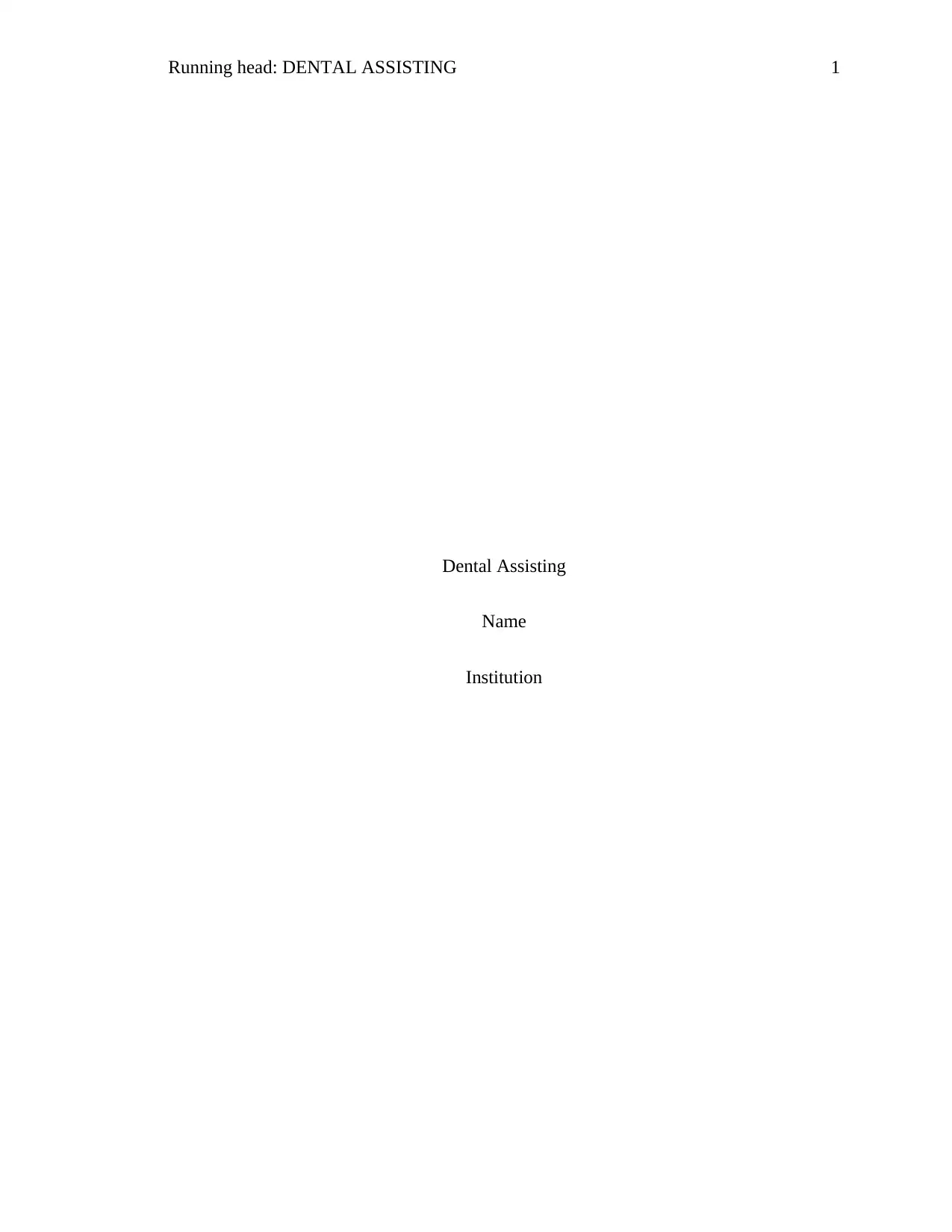
Running head: DENTAL ASSISTING 1
Dental Assisting
Name
Institution
Dental Assisting
Name
Institution
Secure Best Marks with AI Grader
Need help grading? Try our AI Grader for instant feedback on your assignments.
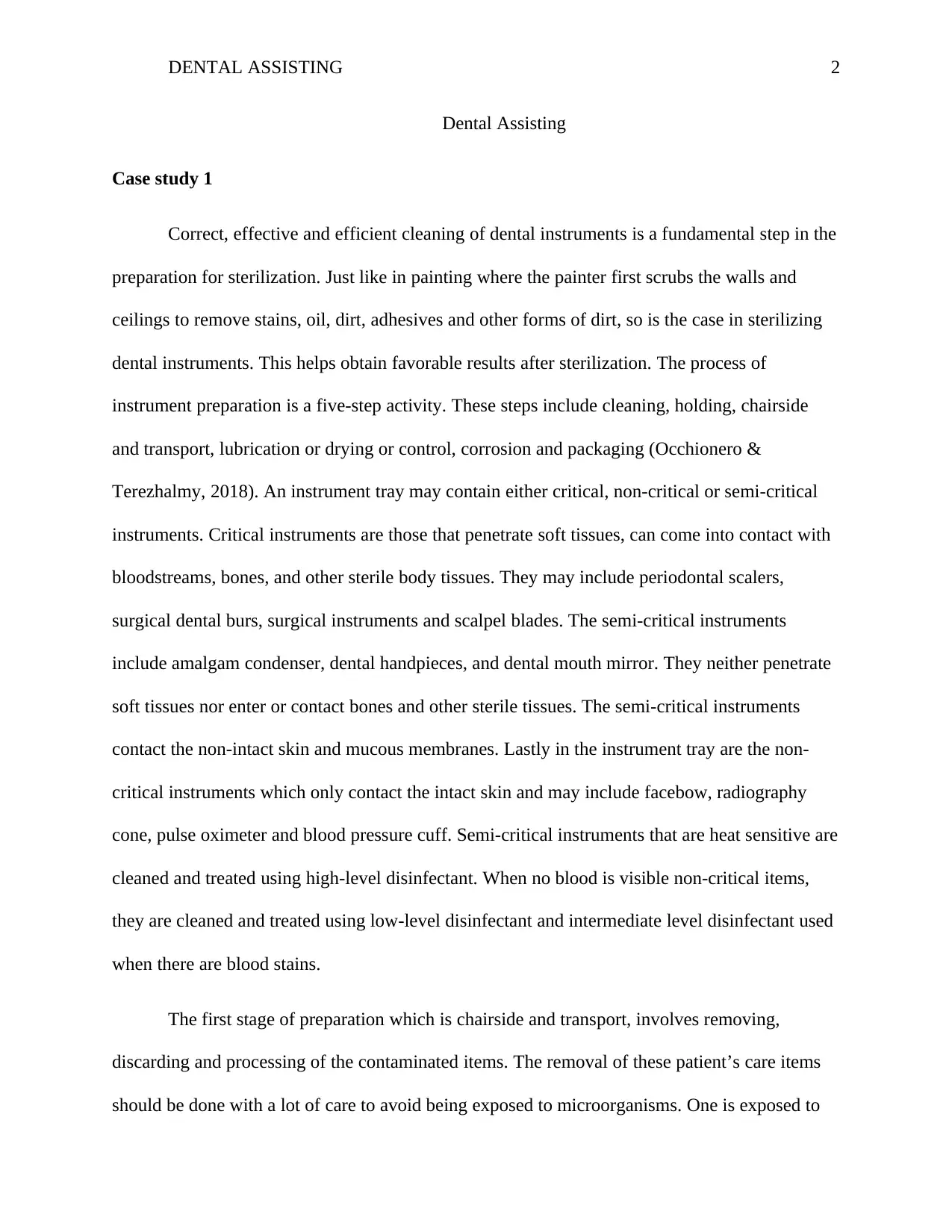
DENTAL ASSISTING 2
Dental Assisting
Case study 1
Correct, effective and efficient cleaning of dental instruments is a fundamental step in the
preparation for sterilization. Just like in painting where the painter first scrubs the walls and
ceilings to remove stains, oil, dirt, adhesives and other forms of dirt, so is the case in sterilizing
dental instruments. This helps obtain favorable results after sterilization. The process of
instrument preparation is a five-step activity. These steps include cleaning, holding, chairside
and transport, lubrication or drying or control, corrosion and packaging (Occhionero &
Terezhalmy, 2018). An instrument tray may contain either critical, non-critical or semi-critical
instruments. Critical instruments are those that penetrate soft tissues, can come into contact with
bloodstreams, bones, and other sterile body tissues. They may include periodontal scalers,
surgical dental burs, surgical instruments and scalpel blades. The semi-critical instruments
include amalgam condenser, dental handpieces, and dental mouth mirror. They neither penetrate
soft tissues nor enter or contact bones and other sterile tissues. The semi-critical instruments
contact the non-intact skin and mucous membranes. Lastly in the instrument tray are the non-
critical instruments which only contact the intact skin and may include facebow, radiography
cone, pulse oximeter and blood pressure cuff. Semi-critical instruments that are heat sensitive are
cleaned and treated using high-level disinfectant. When no blood is visible non-critical items,
they are cleaned and treated using low-level disinfectant and intermediate level disinfectant used
when there are blood stains.
The first stage of preparation which is chairside and transport, involves removing,
discarding and processing of the contaminated items. The removal of these patient’s care items
should be done with a lot of care to avoid being exposed to microorganisms. One is exposed to
Dental Assisting
Case study 1
Correct, effective and efficient cleaning of dental instruments is a fundamental step in the
preparation for sterilization. Just like in painting where the painter first scrubs the walls and
ceilings to remove stains, oil, dirt, adhesives and other forms of dirt, so is the case in sterilizing
dental instruments. This helps obtain favorable results after sterilization. The process of
instrument preparation is a five-step activity. These steps include cleaning, holding, chairside
and transport, lubrication or drying or control, corrosion and packaging (Occhionero &
Terezhalmy, 2018). An instrument tray may contain either critical, non-critical or semi-critical
instruments. Critical instruments are those that penetrate soft tissues, can come into contact with
bloodstreams, bones, and other sterile body tissues. They may include periodontal scalers,
surgical dental burs, surgical instruments and scalpel blades. The semi-critical instruments
include amalgam condenser, dental handpieces, and dental mouth mirror. They neither penetrate
soft tissues nor enter or contact bones and other sterile tissues. The semi-critical instruments
contact the non-intact skin and mucous membranes. Lastly in the instrument tray are the non-
critical instruments which only contact the intact skin and may include facebow, radiography
cone, pulse oximeter and blood pressure cuff. Semi-critical instruments that are heat sensitive are
cleaned and treated using high-level disinfectant. When no blood is visible non-critical items,
they are cleaned and treated using low-level disinfectant and intermediate level disinfectant used
when there are blood stains.
The first stage of preparation which is chairside and transport, involves removing,
discarding and processing of the contaminated items. The removal of these patient’s care items
should be done with a lot of care to avoid being exposed to microorganisms. One is exposed to
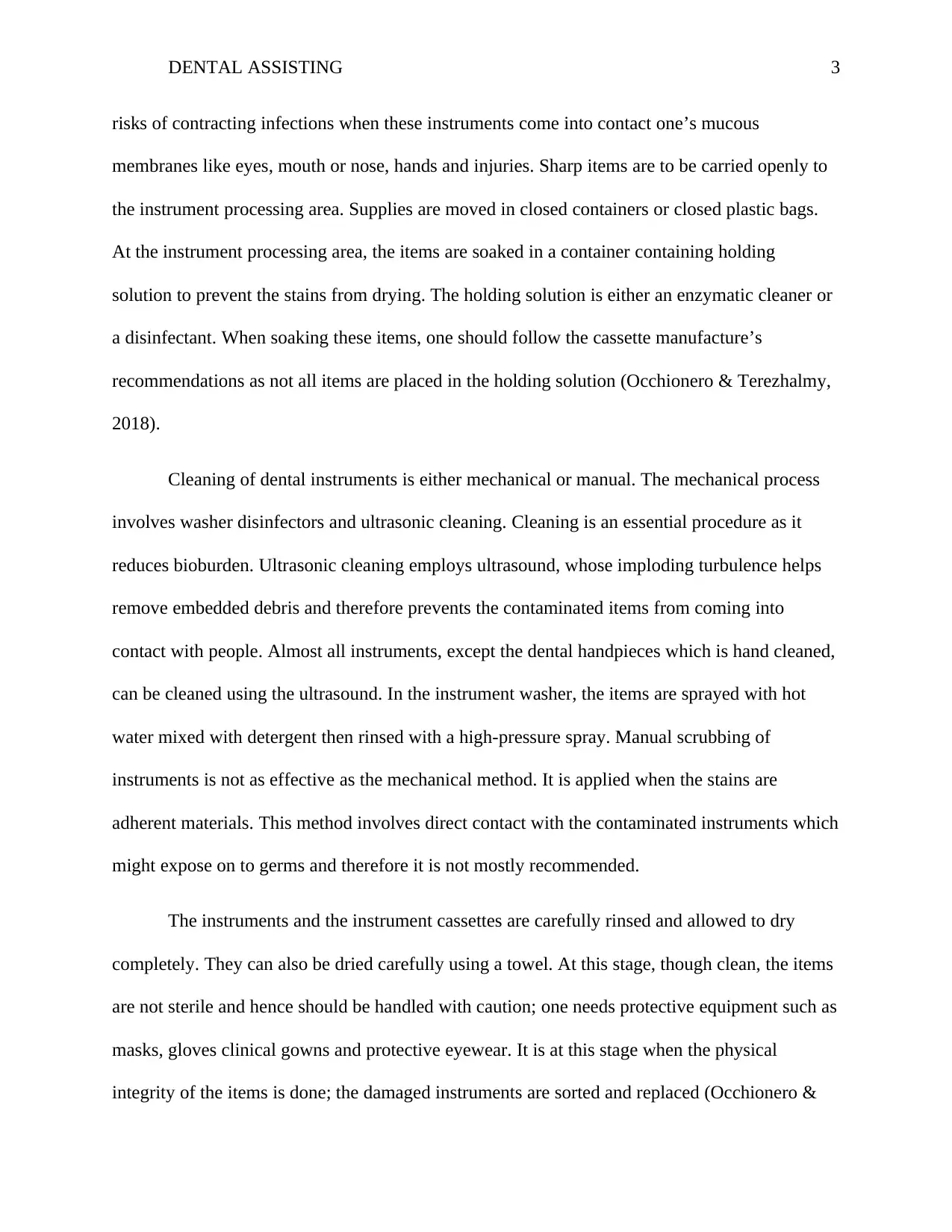
DENTAL ASSISTING 3
risks of contracting infections when these instruments come into contact one’s mucous
membranes like eyes, mouth or nose, hands and injuries. Sharp items are to be carried openly to
the instrument processing area. Supplies are moved in closed containers or closed plastic bags.
At the instrument processing area, the items are soaked in a container containing holding
solution to prevent the stains from drying. The holding solution is either an enzymatic cleaner or
a disinfectant. When soaking these items, one should follow the cassette manufacture’s
recommendations as not all items are placed in the holding solution (Occhionero & Terezhalmy,
2018).
Cleaning of dental instruments is either mechanical or manual. The mechanical process
involves washer disinfectors and ultrasonic cleaning. Cleaning is an essential procedure as it
reduces bioburden. Ultrasonic cleaning employs ultrasound, whose imploding turbulence helps
remove embedded debris and therefore prevents the contaminated items from coming into
contact with people. Almost all instruments, except the dental handpieces which is hand cleaned,
can be cleaned using the ultrasound. In the instrument washer, the items are sprayed with hot
water mixed with detergent then rinsed with a high-pressure spray. Manual scrubbing of
instruments is not as effective as the mechanical method. It is applied when the stains are
adherent materials. This method involves direct contact with the contaminated instruments which
might expose on to germs and therefore it is not mostly recommended.
The instruments and the instrument cassettes are carefully rinsed and allowed to dry
completely. They can also be dried carefully using a towel. At this stage, though clean, the items
are not sterile and hence should be handled with caution; one needs protective equipment such as
masks, gloves clinical gowns and protective eyewear. It is at this stage when the physical
integrity of the items is done; the damaged instruments are sorted and replaced (Occhionero &
risks of contracting infections when these instruments come into contact one’s mucous
membranes like eyes, mouth or nose, hands and injuries. Sharp items are to be carried openly to
the instrument processing area. Supplies are moved in closed containers or closed plastic bags.
At the instrument processing area, the items are soaked in a container containing holding
solution to prevent the stains from drying. The holding solution is either an enzymatic cleaner or
a disinfectant. When soaking these items, one should follow the cassette manufacture’s
recommendations as not all items are placed in the holding solution (Occhionero & Terezhalmy,
2018).
Cleaning of dental instruments is either mechanical or manual. The mechanical process
involves washer disinfectors and ultrasonic cleaning. Cleaning is an essential procedure as it
reduces bioburden. Ultrasonic cleaning employs ultrasound, whose imploding turbulence helps
remove embedded debris and therefore prevents the contaminated items from coming into
contact with people. Almost all instruments, except the dental handpieces which is hand cleaned,
can be cleaned using the ultrasound. In the instrument washer, the items are sprayed with hot
water mixed with detergent then rinsed with a high-pressure spray. Manual scrubbing of
instruments is not as effective as the mechanical method. It is applied when the stains are
adherent materials. This method involves direct contact with the contaminated instruments which
might expose on to germs and therefore it is not mostly recommended.
The instruments and the instrument cassettes are carefully rinsed and allowed to dry
completely. They can also be dried carefully using a towel. At this stage, though clean, the items
are not sterile and hence should be handled with caution; one needs protective equipment such as
masks, gloves clinical gowns and protective eyewear. It is at this stage when the physical
integrity of the items is done; the damaged instruments are sorted and replaced (Occhionero &
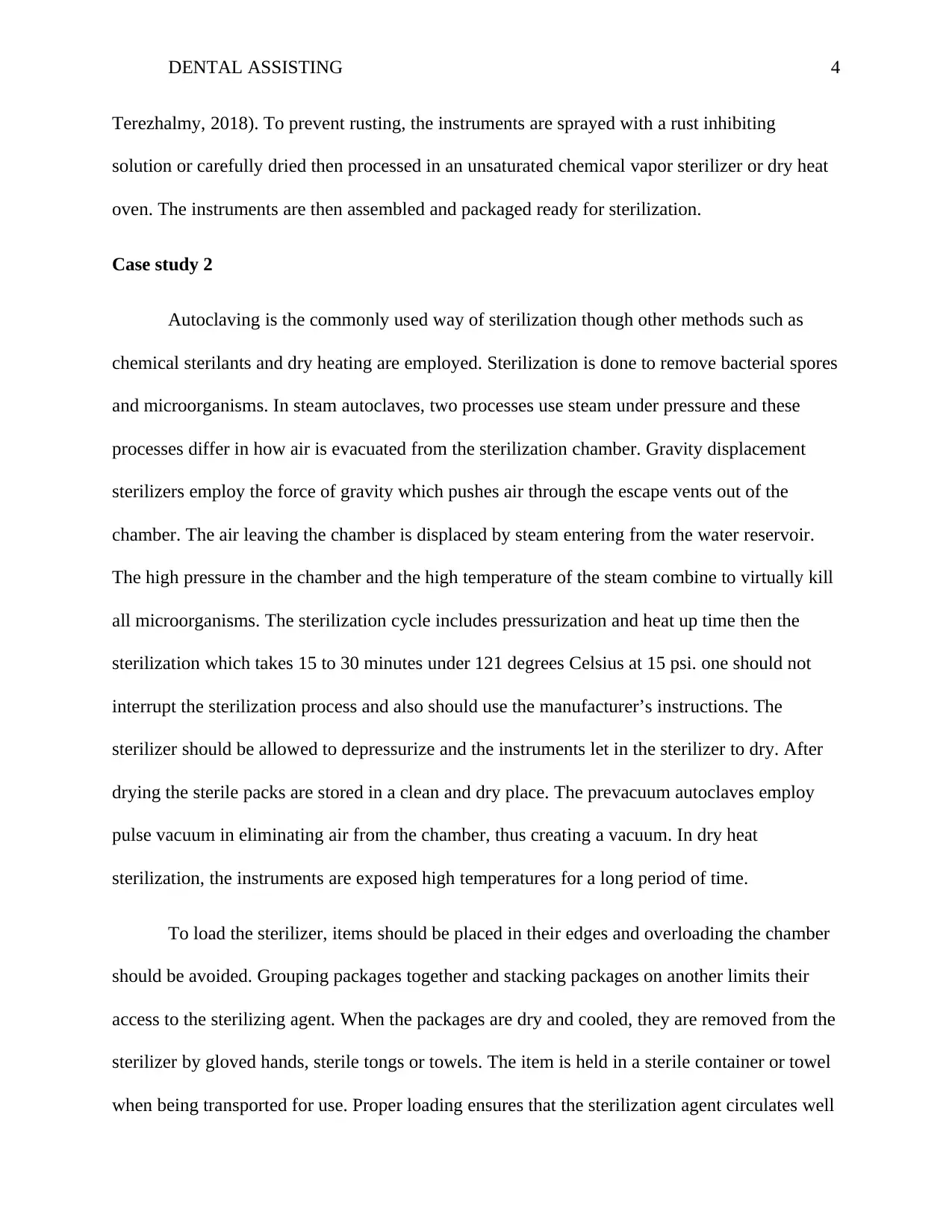
DENTAL ASSISTING 4
Terezhalmy, 2018). To prevent rusting, the instruments are sprayed with a rust inhibiting
solution or carefully dried then processed in an unsaturated chemical vapor sterilizer or dry heat
oven. The instruments are then assembled and packaged ready for sterilization.
Case study 2
Autoclaving is the commonly used way of sterilization though other methods such as
chemical sterilants and dry heating are employed. Sterilization is done to remove bacterial spores
and microorganisms. In steam autoclaves, two processes use steam under pressure and these
processes differ in how air is evacuated from the sterilization chamber. Gravity displacement
sterilizers employ the force of gravity which pushes air through the escape vents out of the
chamber. The air leaving the chamber is displaced by steam entering from the water reservoir.
The high pressure in the chamber and the high temperature of the steam combine to virtually kill
all microorganisms. The sterilization cycle includes pressurization and heat up time then the
sterilization which takes 15 to 30 minutes under 121 degrees Celsius at 15 psi. one should not
interrupt the sterilization process and also should use the manufacturer’s instructions. The
sterilizer should be allowed to depressurize and the instruments let in the sterilizer to dry. After
drying the sterile packs are stored in a clean and dry place. The prevacuum autoclaves employ
pulse vacuum in eliminating air from the chamber, thus creating a vacuum. In dry heat
sterilization, the instruments are exposed high temperatures for a long period of time.
To load the sterilizer, items should be placed in their edges and overloading the chamber
should be avoided. Grouping packages together and stacking packages on another limits their
access to the sterilizing agent. When the packages are dry and cooled, they are removed from the
sterilizer by gloved hands, sterile tongs or towels. The item is held in a sterile container or towel
when being transported for use. Proper loading ensures that the sterilization agent circulates well
Terezhalmy, 2018). To prevent rusting, the instruments are sprayed with a rust inhibiting
solution or carefully dried then processed in an unsaturated chemical vapor sterilizer or dry heat
oven. The instruments are then assembled and packaged ready for sterilization.
Case study 2
Autoclaving is the commonly used way of sterilization though other methods such as
chemical sterilants and dry heating are employed. Sterilization is done to remove bacterial spores
and microorganisms. In steam autoclaves, two processes use steam under pressure and these
processes differ in how air is evacuated from the sterilization chamber. Gravity displacement
sterilizers employ the force of gravity which pushes air through the escape vents out of the
chamber. The air leaving the chamber is displaced by steam entering from the water reservoir.
The high pressure in the chamber and the high temperature of the steam combine to virtually kill
all microorganisms. The sterilization cycle includes pressurization and heat up time then the
sterilization which takes 15 to 30 minutes under 121 degrees Celsius at 15 psi. one should not
interrupt the sterilization process and also should use the manufacturer’s instructions. The
sterilizer should be allowed to depressurize and the instruments let in the sterilizer to dry. After
drying the sterile packs are stored in a clean and dry place. The prevacuum autoclaves employ
pulse vacuum in eliminating air from the chamber, thus creating a vacuum. In dry heat
sterilization, the instruments are exposed high temperatures for a long period of time.
To load the sterilizer, items should be placed in their edges and overloading the chamber
should be avoided. Grouping packages together and stacking packages on another limits their
access to the sterilizing agent. When the packages are dry and cooled, they are removed from the
sterilizer by gloved hands, sterile tongs or towels. The item is held in a sterile container or towel
when being transported for use. Proper loading ensures that the sterilization agent circulates well
Secure Best Marks with AI Grader
Need help grading? Try our AI Grader for instant feedback on your assignments.
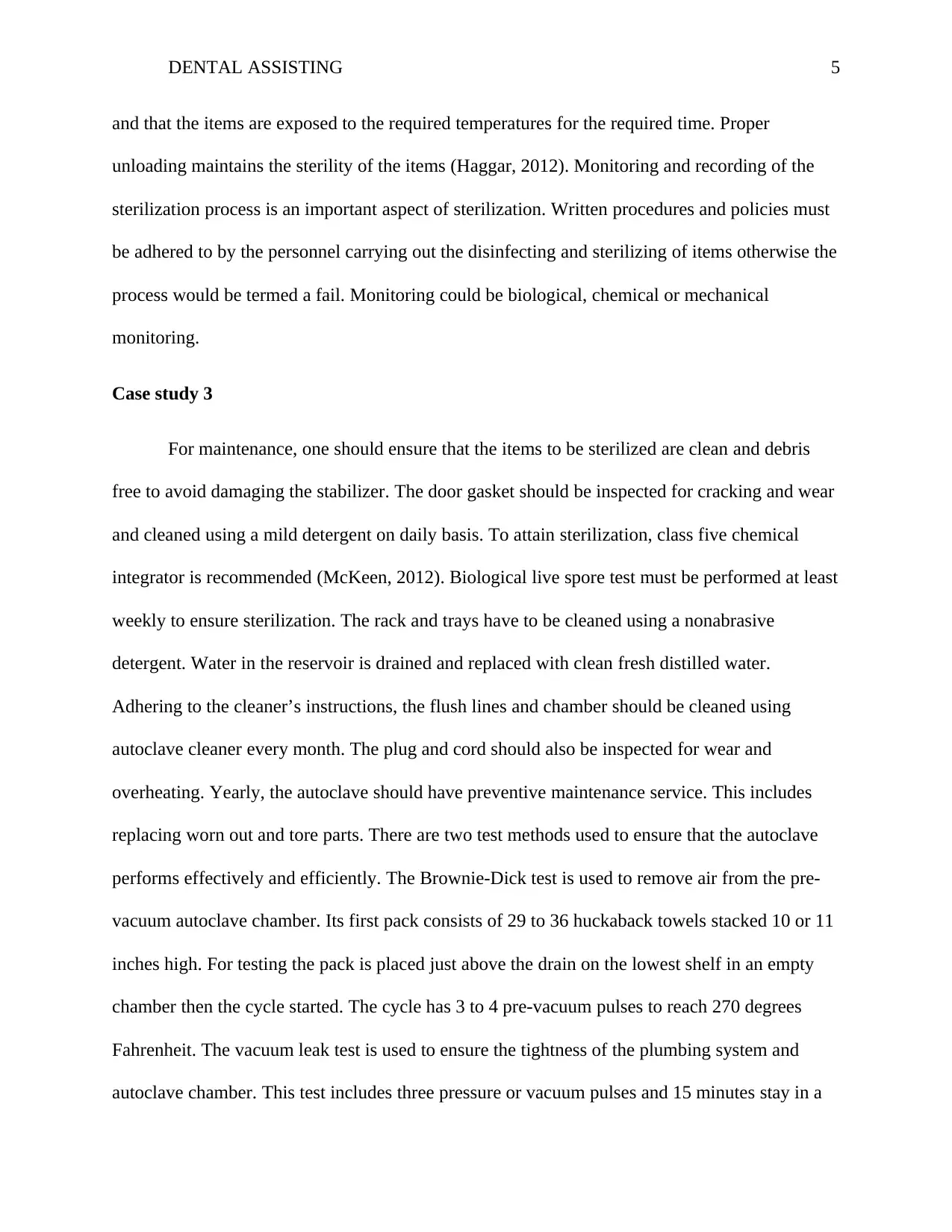
DENTAL ASSISTING 5
and that the items are exposed to the required temperatures for the required time. Proper
unloading maintains the sterility of the items (Haggar, 2012). Monitoring and recording of the
sterilization process is an important aspect of sterilization. Written procedures and policies must
be adhered to by the personnel carrying out the disinfecting and sterilizing of items otherwise the
process would be termed a fail. Monitoring could be biological, chemical or mechanical
monitoring.
Case study 3
For maintenance, one should ensure that the items to be sterilized are clean and debris
free to avoid damaging the stabilizer. The door gasket should be inspected for cracking and wear
and cleaned using a mild detergent on daily basis. To attain sterilization, class five chemical
integrator is recommended (McKeen, 2012). Biological live spore test must be performed at least
weekly to ensure sterilization. The rack and trays have to be cleaned using a nonabrasive
detergent. Water in the reservoir is drained and replaced with clean fresh distilled water.
Adhering to the cleaner’s instructions, the flush lines and chamber should be cleaned using
autoclave cleaner every month. The plug and cord should also be inspected for wear and
overheating. Yearly, the autoclave should have preventive maintenance service. This includes
replacing worn out and tore parts. There are two test methods used to ensure that the autoclave
performs effectively and efficiently. The Brownie-Dick test is used to remove air from the pre-
vacuum autoclave chamber. Its first pack consists of 29 to 36 huckaback towels stacked 10 or 11
inches high. For testing the pack is placed just above the drain on the lowest shelf in an empty
chamber then the cycle started. The cycle has 3 to 4 pre-vacuum pulses to reach 270 degrees
Fahrenheit. The vacuum leak test is used to ensure the tightness of the plumbing system and
autoclave chamber. This test includes three pressure or vacuum pulses and 15 minutes stay in a
and that the items are exposed to the required temperatures for the required time. Proper
unloading maintains the sterility of the items (Haggar, 2012). Monitoring and recording of the
sterilization process is an important aspect of sterilization. Written procedures and policies must
be adhered to by the personnel carrying out the disinfecting and sterilizing of items otherwise the
process would be termed a fail. Monitoring could be biological, chemical or mechanical
monitoring.
Case study 3
For maintenance, one should ensure that the items to be sterilized are clean and debris
free to avoid damaging the stabilizer. The door gasket should be inspected for cracking and wear
and cleaned using a mild detergent on daily basis. To attain sterilization, class five chemical
integrator is recommended (McKeen, 2012). Biological live spore test must be performed at least
weekly to ensure sterilization. The rack and trays have to be cleaned using a nonabrasive
detergent. Water in the reservoir is drained and replaced with clean fresh distilled water.
Adhering to the cleaner’s instructions, the flush lines and chamber should be cleaned using
autoclave cleaner every month. The plug and cord should also be inspected for wear and
overheating. Yearly, the autoclave should have preventive maintenance service. This includes
replacing worn out and tore parts. There are two test methods used to ensure that the autoclave
performs effectively and efficiently. The Brownie-Dick test is used to remove air from the pre-
vacuum autoclave chamber. Its first pack consists of 29 to 36 huckaback towels stacked 10 or 11
inches high. For testing the pack is placed just above the drain on the lowest shelf in an empty
chamber then the cycle started. The cycle has 3 to 4 pre-vacuum pulses to reach 270 degrees
Fahrenheit. The vacuum leak test is used to ensure the tightness of the plumbing system and
autoclave chamber. This test includes three pressure or vacuum pulses and 15 minutes stay in a
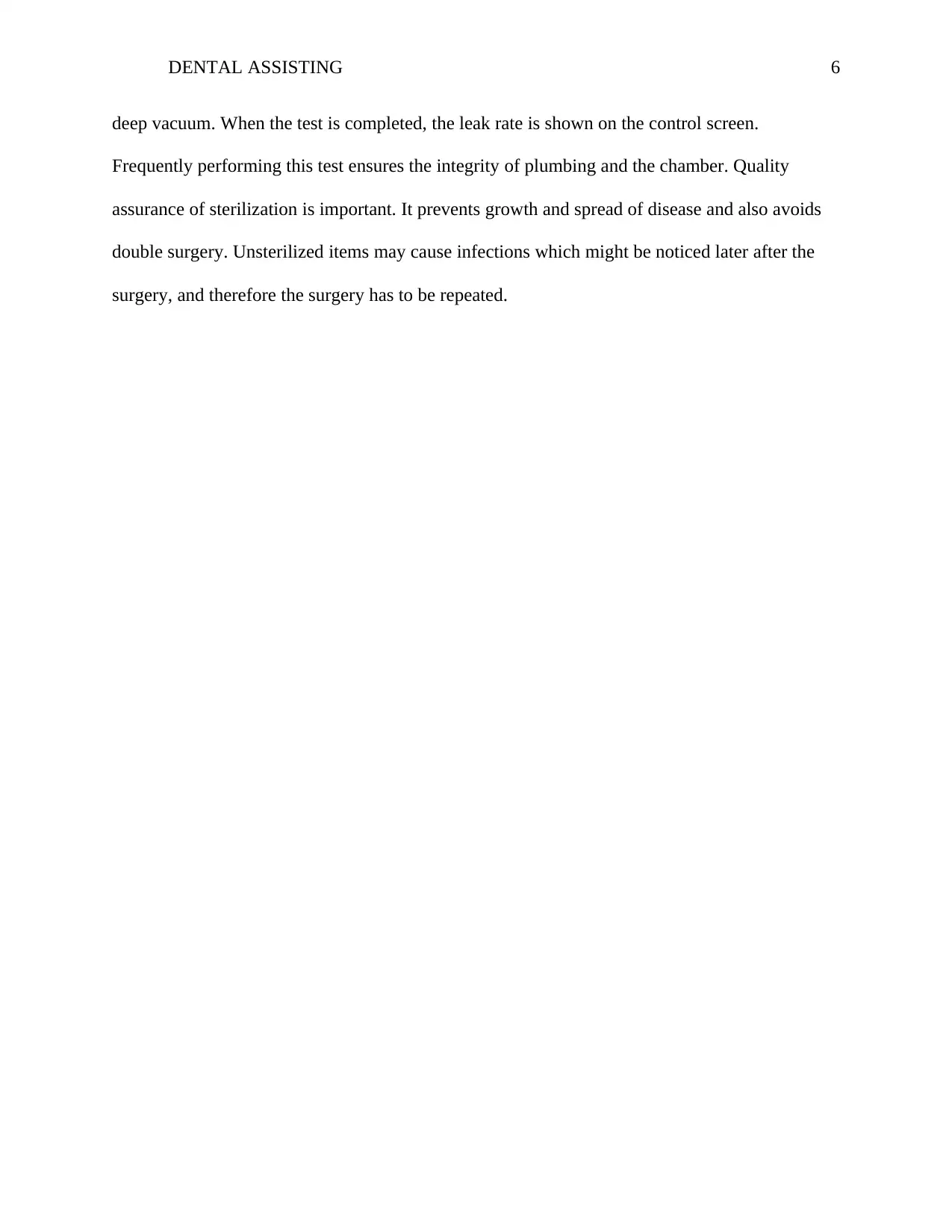
DENTAL ASSISTING 6
deep vacuum. When the test is completed, the leak rate is shown on the control screen.
Frequently performing this test ensures the integrity of plumbing and the chamber. Quality
assurance of sterilization is important. It prevents growth and spread of disease and also avoids
double surgery. Unsterilized items may cause infections which might be noticed later after the
surgery, and therefore the surgery has to be repeated.
deep vacuum. When the test is completed, the leak rate is shown on the control screen.
Frequently performing this test ensures the integrity of plumbing and the chamber. Quality
assurance of sterilization is important. It prevents growth and spread of disease and also avoids
double surgery. Unsterilized items may cause infections which might be noticed later after the
surgery, and therefore the surgery has to be repeated.
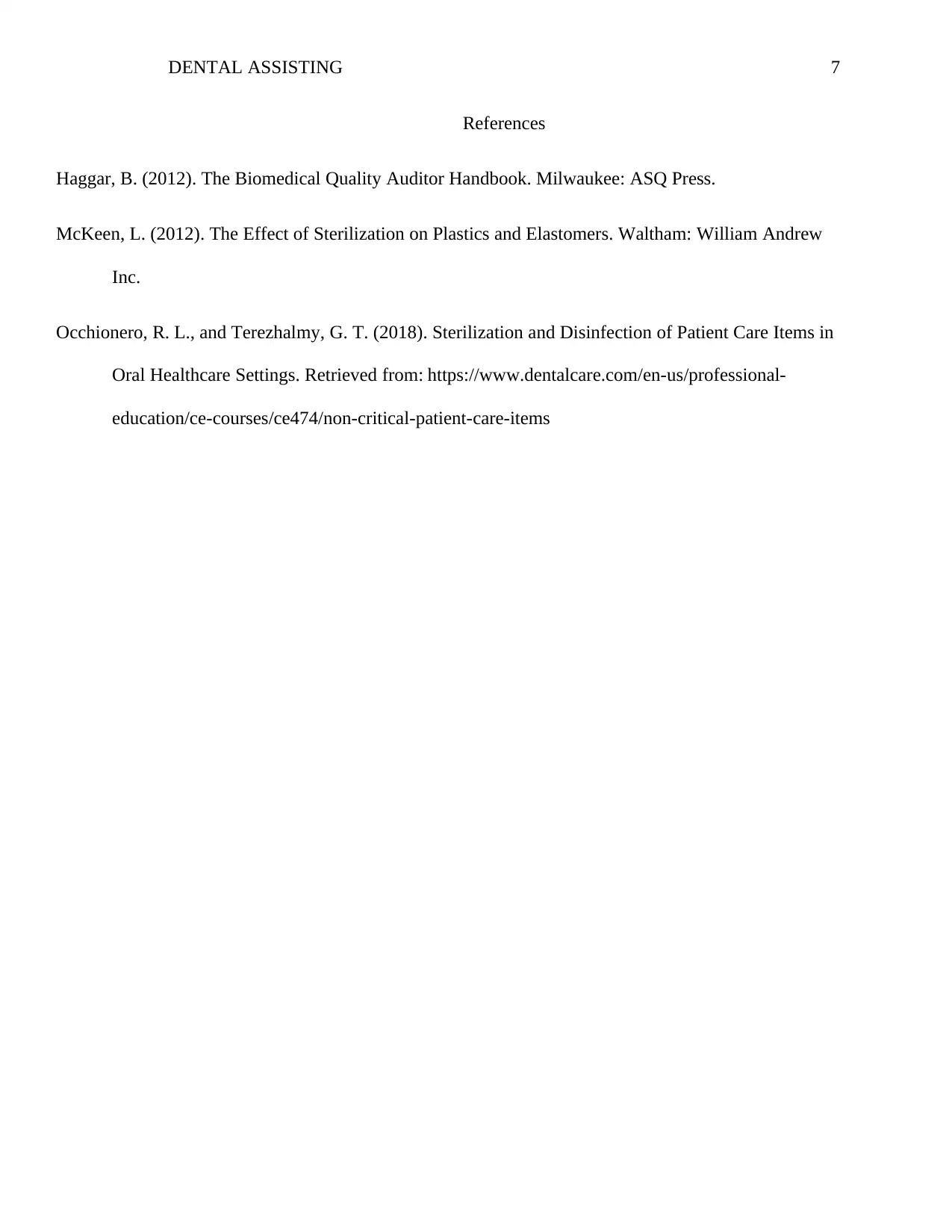
DENTAL ASSISTING 7
References
Haggar, B. (2012). The Biomedical Quality Auditor Handbook. Milwaukee: ASQ Press.
McKeen, L. (2012). The Effect of Sterilization on Plastics and Elastomers. Waltham: William Andrew
Inc.
Occhionero, R. L., and Terezhalmy, G. T. (2018). Sterilization and Disinfection of Patient Care Items in
Oral Healthcare Settings. Retrieved from: https://www.dentalcare.com/en-us/professional-
education/ce-courses/ce474/non-critical-patient-care-items
References
Haggar, B. (2012). The Biomedical Quality Auditor Handbook. Milwaukee: ASQ Press.
McKeen, L. (2012). The Effect of Sterilization on Plastics and Elastomers. Waltham: William Andrew
Inc.
Occhionero, R. L., and Terezhalmy, G. T. (2018). Sterilization and Disinfection of Patient Care Items in
Oral Healthcare Settings. Retrieved from: https://www.dentalcare.com/en-us/professional-
education/ce-courses/ce474/non-critical-patient-care-items
1 out of 7
Your All-in-One AI-Powered Toolkit for Academic Success.
+13062052269
info@desklib.com
Available 24*7 on WhatsApp / Email
![[object Object]](/_next/static/media/star-bottom.7253800d.svg)
Unlock your academic potential
© 2024 | Zucol Services PVT LTD | All rights reserved.

